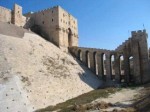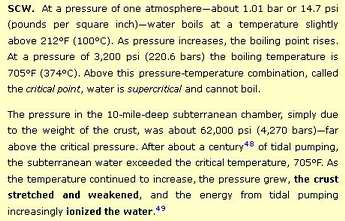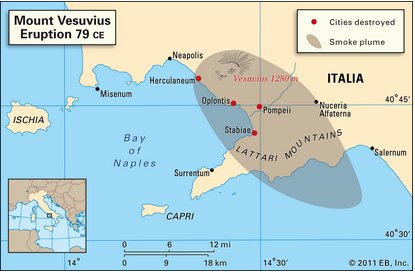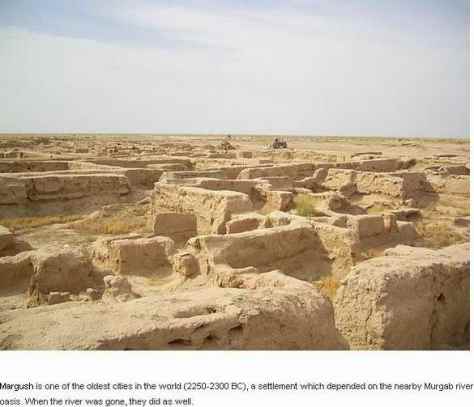by Lu Paradise • 4,388 views
Great disasters have always taken place all throughout history causing huge loss of life. Most were natural disasters, although some were caused by human intervention or negligence, as today many floods and landslides are caused by over-cutting of forests high up in the mountains. It is a fact that in antiquity there was more and greater volcanic activity than before the 20th century, so earthquakes, floods and tsunamis were more frequent until then. Sad to say it appears that since the beginning of the last century earthquakes and tsunamis are on the rise again, as well as more human caused disasters caused by human intervention, like the recent earthquakes in Sichuan were caused by the construction of the Chinese huge and heavy Three Gorges Dam.
This now extended 13 to 1 list counts down in time from recent AD to ancient BC: Download this article as powerpoint here!
13: Syrian Earthquake
–Syria to Egypt, 1202 AD
![]()
In 1202 AD, a devastating massive earthquake hit an area from Egypt to Syria, where the epicenter was. It is said to have caused 1.1 million deaths. That would be one of the largest earthquakes in all of history.
12: Damghan Earthquake
— Iran, 856 AD
![]()
 The Damghan Earthquake was an earthquake of magnitude 7.9, that struck a 200-mile (320 km) stretch of Iran on 22 December, 856 A.D. The earthquake’s epicenter was said to be directly below the city of Damghan, which was then the capital of Iran. It caused approximately 200,000 deaths, making it the fifth deadliest earthquake in recorded history. The earthquake was caused by the Alpide earthquake belt, a name for the geologic force that created a mountain range named the Alpide belt, which is among the most seismically active areas on earth. [Source]
The Damghan Earthquake was an earthquake of magnitude 7.9, that struck a 200-mile (320 km) stretch of Iran on 22 December, 856 A.D. The earthquake’s epicenter was said to be directly below the city of Damghan, which was then the capital of Iran. It caused approximately 200,000 deaths, making it the fifth deadliest earthquake in recorded history. The earthquake was caused by the Alpide earthquake belt, a name for the geologic force that created a mountain range named the Alpide belt, which is among the most seismically active areas on earth. [Source]
11: Plague of Justinian
— Eastern Roman Empire, 541 AD
![]()
The Plague of Justinian was a pandemic that afflicted the Eastern Roman Empire (Byzantine Empire), including its capital Constantinople, in the years 541–542 AD.
The most commonly accepted cause of the pandemic is bubonic plague, which later became infamous for either causing, or for contributing to, the Black Death of the 14th century. The plagues’ social and cultural impact during this period is comparable to that of the Black Death. In the views of 6th century Western historians, it was nearly worldwide in scope, striking central and south Asia, North Africa and Arabia, and Europe as far north as Denmark and as far west as Ireland. Until about 750, the plague would return with each generation throughout the Mediterranean basin. The wave of disease would also have a major impact on the future course of European history. Modern historians named this plague incident after the Eastern Roman Emperor Justinian I, who was in power at the time. He contracted the disease, but was one of a limited number of survivors. The death toll from this series of plagues was an unbelievable 40 to 100 million.
10: Antioch Earthquake
In late May 526 AD an earthquake struck Syria and the city of Antiochia, which were then part of the Byzantine empire. The death toll was a massive 250,000 dead.
The quake caused the port of Seleucia Pieria to rise up by nearly one meter resulting in the silting of the harbor. It was the 3rd deadliest earthquake of all time. The quake is estimated to have been over 7 on the Richter scale (VIII on the Mercalli scale). After the earthquake a fire broke out which razed all buildings that had not already been destroyed.
9: Crete Earthquake and Alexandria Tsunami
— Greece and N. Africa, July 21, 365 AD
![]()
 On July 21, 365 AD, an earthquake occurred under the Mediterranean Sea. It is thought that the earthquake was centered near Greek island of Crete and that it was a magnitude eight or greater. It destroyed nearly all of the towns on the island. It would have also caused damage in other areas of Greece, Libya, Cyprus and Sicily.
On July 21, 365 AD, an earthquake occurred under the Mediterranean Sea. It is thought that the earthquake was centered near Greek island of Crete and that it was a magnitude eight or greater. It destroyed nearly all of the towns on the island. It would have also caused damage in other areas of Greece, Libya, Cyprus and Sicily.
 After the earthquake, a tsunami caused significant damage in Alexandria, Egypt and other areas. It was documented best in Alexandria. Writings from the time tell us that ships were carried as far as two miles inland by the wave.
After the earthquake, a tsunami caused significant damage in Alexandria, Egypt and other areas. It was documented best in Alexandria. Writings from the time tell us that ships were carried as far as two miles inland by the wave.
A description by Ammianus Marcellinus describes the effect of the earthquake and the resulting tsunami in detail. He wrote of how the earth shook and then the ocean receded in Alexandria and how a great wave inundated the city with seawater. It is estimated that thousands of people were killed.
8: The Antonine Plague
 The Antonine Plague is named after one of its possible victims, Marcus Aurelius Antoninus, the Emperor of Rome. It is otherwise known as the plague of Galen.
The Antonine Plague is named after one of its possible victims, Marcus Aurelius Antoninus, the Emperor of Rome. It is otherwise known as the plague of Galen.
Galen was a Greek physician who documented the plague. Judging by his description, historians believe that the Antonine Plague was caused by smallpox or measles. We can call this plague a natural disaster because it was caused by a naturally occurring disease and it killed a significant number of people.
The Antonine Plague is thought to have come from Roman soldiers returning from battle in the east. Over time, it spread throughout the Roman Empire and some of the tribes to the north. An estimated 5 million people were killed by the Antonine plague. During a second outbreak, a Roman historian named Dio Cassius wrote that 2,000 people were dying each day in Rome. That’s roughly one-fourth of those who were infected.
7: Eruption of Mount Vesuvius
— Bay of Naples, Pompeii Italy, August 24, 79 AD
![]()
 The 79 AD eruption of Mount Vesuvius, and the subsequent destruction of Pompeii and Herculaneum, reminds us of the awesome power of this active volcano. In fact, Vesuvius may be the most dangerous volcano on Earth. There are more people living in its vicinity than any other active volcano. Furthermore, it is most certainly going to erupt again.
The 79 AD eruption of Mount Vesuvius, and the subsequent destruction of Pompeii and Herculaneum, reminds us of the awesome power of this active volcano. In fact, Vesuvius may be the most dangerous volcano on Earth. There are more people living in its vicinity than any other active volcano. Furthermore, it is most certainly going to erupt again.
When Mount Vesuvius erupted in 79 AD, it warned the people with an earthquake, which was ignored. The earthquake was later followed by the expulsion of volcanic debris and the appearance of an ominous cloud over the mountain. Pompeii was only 5 miles from the volcano; Herculaneum was even closer. The people of these towns died as one might expect victims of a volcano to die; they choked, burned and were subsequently covered in volcanic debris and run off. What makes this ancient natural disaster so interesting is the evidence we have of it.
For more than 1500 years, Pompeii lay buried in Italy. It was found when residents were cleaning up after another major eruption, in 1631 AD. It was not completely uncovered until the 20th century. Then, people learned all to well the horrible fate that had befallen its ancient residents. The agony of their deaths has been immortalized in plaster. Because their bodies rotted away long ago, while entombed in volcanic rock, cavities, like those found in fossils, were left behind. These were filled with plaster and what came out were near-perfect statues of the people who died in Pompeii, as they had died. There were thousands of victims. Today, there could be millions.
————— B.C 0 A.D —————–
6: Helike Tsunami and Earthquake
 Helike was submerged in the Gulf of Corinth by an earthquake and a tsunami in 373 BC. It remains submerged to this day.
Helike was submerged in the Gulf of Corinth by an earthquake and a tsunami in 373 BC. It remains submerged to this day.
Ancient writers commented on the destruction and some mentioned that you could see the ruins beneath the water for hundreds of years after the disaster. It is assumed that a number of people lost their lives, but how many is uncertain.
The search for Helike did not begin until the end of the past century. Since then, relics of Helike and, interestingly, other towns have been found. Walls, walkways, coins and more have been viewed and photographed. This is yet another possible scene of Atlantis, according to some. However, the destruction of Helike happened in Plato’s lifetime. He wrote that it happened 9,000 years before his time. It could have been inspiration for fiction, though.
A number of other, smaller, natural disasters occurred throughout ancient times. People were subject to them then as much as we are today. It makes you wonder how many civilizations were destroyed by natural disaster that we have no knowledge of, as of yet.
5: ‘Bronze Age Collapse’ Drought & Climate Change
— Wide swath from Sahara, Mesopotamia, Indus valley, etc. ± 1300-1200 BC.
![]()
Before this time the Sahara was no desert, but well-watered by much rain, making it a place to raise cattle, even causing heavy erosion on the limestone Sphinx and pyramids. The Indus valley’s Harrapan civilisation, Gonur & Margush in Turkmenistan, many cities in the Sahel, Arabia, Israel, and Mesopotamia used to be very different than today; flourishing, well-watered, looking green and verdant! But then the rains virtually stopped turning them into the deserts they are today, its cities abandoned, desolate, & dusted over.
“In a short period of time, the entire world of the Bronze Age crumbled,” says Israel Finkelstein, an archaeologist at the Institute of Archaeology at Tel Aviv University, who was one of the lead scientists in a pollen particles study. “The Hittite Empire, Egypt of the pharaohs, the Mycenaean culture in Greece, the copper-producing kingdom located on the island of Cyprus, the great trade emporium of Ugarit on the Syrian coast, and the Canaanite city—states under Egyptian hegemony—all disappeared and only after a while were replaced by the territorial kingdoms of the Iron Age, including Israel and Judah.”
Wars, pestilence, and sudden natural disasters have all been postulated as possible causes, but now, thanks to sophisticated pollen-sampling techniques and advances in radiocarbon dating, Finkelstein and his colleagues believe they know the primary culprit: drought, or rather a succession of severe droughts over a 150-year period from 1250 BC to about 1100 BC.
4: End Ice Age 130 M-300 Ft. Ocean Level Rise!
— Disastrous global inundation of continental coastlines — around 1500-1400 B.C.
![]()
 When the real Ice Age came to an end due to real climate change as the oceans cooled down to the present day level, the huge kilometers thick ice caps of the North and on the mountain ranges began to melt and the rains lessened.
When the real Ice Age came to an end due to real climate change as the oceans cooled down to the present day level, the huge kilometers thick ice caps of the North and on the mountain ranges began to melt and the rains lessened.
Results were disastrous! Entire low lying land areas were submerged in sea water, and islands like Ireland and England shrunk down to their present size. The entire area between Norway, Denmark, Holland, England, once called Doggerland, was submerged and became the North Sea! Taiwan and China were separated whereas before they were one landmass. (Red parts in map are now under water!)
FLOODING OF SUNDA, MU & ATLANTIS
Before the melting, it was virtually possible to walk all the way from Thailand over land-bridges to Australia, which then became mere islands separated by the sea!
This sea level rise was also the very reason for the “sinking” of Atlantis, the legendary island city of the thalassocracy (sea empire) founded by King Atlas the star-mapper in and around the Atlantic ocean and inside the ‘Pillars of Hercules’ or Gibraltar in North Africa near the Atlas Mountains!
And the sinking of Sunda, Mu, Chinese islands, and other lands in the Pacific, sank underwater as well! See our detailed article on Atlantis (and Sunda, etc)
FLOODING OF THE BLACK SEA
Another cataclysmic inundation took place in the Black Sea, once called the Euxine Lake. It used to be much smaller and the original coast-line much lower. The Russian icecap melt-water made the Dniepr river widen out, transporting trillions of tons of water into the lake. It is our theory that the Black Sea was overflown inside out from its four Northern D rivers; Don, Dnieper, Dniester, Danube, rather than from the Mediterranean, acc. to the tsunami legend of the islanders of Samo-Thrace, stating it came from the Bosporus!
 Celtic and Thracian tribes had to flee their flooded Bronze Age homes and towns. The water finally broke through the Dardanelles (named after King Dardanus around the time of Troy) into the Aegean sea, severely inundating coastlines and islands like Samo-Thrace with tsunamis.
Celtic and Thracian tribes had to flee their flooded Bronze Age homes and towns. The water finally broke through the Dardanelles (named after King Dardanus around the time of Troy) into the Aegean sea, severely inundating coastlines and islands like Samo-Thrace with tsunamis.
The lessening rain caused permanent droughts in the Sahara, Middle East, Indus valley and elsewhere, prompting the Bronze Age Collapse, forcing large tribal migrations throughout the world, like the Sea peoples, the Atlantioi, and the Olmecs from the Lybico-Berber speaking Mande tribe in W-Africa!
SINKING OF DWARAKA & KUMARI KANDAM
And yet another famous inundation happened in Western India. A famous city called Dwar(a)ka named as the city of Krishna, was 100 KM inland, yet was swallowed by the waves as recorded by Arjuna, one of his disciples, in the Mahabharata, around 1500 BC. Remnants of the city have been found underwater.
The importance of the discovery of Dwaraka lies not merely in providing archaeological evidence needed for corroborating the traditional account of the submergence of Dwaraka but also indirectly fixing the date of the Mahabharata. Pottery found at the archaeological site bears resemblance to pottery found at another site (Bet Dwaraka) which dates to around 1500 BC.
Furthermore, the discovery may shed light on other cities in ancient India which may have vanished by flooding, such as Indraprastha and Pataliputra, Kumari Kandam, and Rama’s Bridge between Lanka and India! The bulk of these contemporary findings are attributed to S.R. Rao, formerly of the Archaeological Survey of India, but severely criticised by the Indian Far Left. (Naturally! Politically required to prop up thusly threatened Darwinist Atheism!)
3: Minoan Eruption of Thera Santorini
— Islands Santorini, Crete & Greece, ± 1645 BC![]()
 Sometime around 1645 BC, a volcano erupted on the island of Thera (Santorini) The massive eruption caused widespread damage on both Santorini and the Minoan settlement at Akrotiri, as well as communities and agricultural areas on the nearby island of Crete. At the time, the Minoans occupied both islands. The town on Santorini was not rediscovered until modern times.
Sometime around 1645 BC, a volcano erupted on the island of Thera (Santorini) The massive eruption caused widespread damage on both Santorini and the Minoan settlement at Akrotiri, as well as communities and agricultural areas on the nearby island of Crete. At the time, the Minoans occupied both islands. The town on Santorini was not rediscovered until modern times.
It is assumed that the ancient inhabitants of these islands picked up warnings that the volcano was going to erupt, and heeded them. No victims of the eruption, if there were any, have been found. Furthermore, it appears as if all transportable, valuable items were removed prior to the eruption. Nonetheless, archaeologists have discovered buildings and large belongings remained.
The Minoan eruption was one of the largest plinian eruptions (‘plinian’ produces powerful convecting plumes of ash) on earth. The so-far established size estimations were largely based on field data from Santorini, neighboring islands, from the sea bed, and western Turkey, where the deposit can still be found in lake deposits. The traditional and to-date most widely accepted value of the erupted magma volume of the Minoan eruption ranges between 30-40 cubic km, corresponding to a total tephra (volume of erupted ejecta) of about 80-90 km3, and takes into account various field data obtained and modeling done between around 1970-1990 (e.g. Sigurdsson et al, 1990).
Recently, new outcrops of the Minoan tephra (e.g. 2 m on Anafi Island, on the sea floor around Santorini and elsewhere) have become available. These findings suggest that the eruption could be larger than originally thought, ranking in fact as VEI 7, which would make it perhaps the second largest explosive eruption in historic time on the planet (after Tambora 1815).
 An eruption of this size likely had far-reaching impacts on the environment and civilizations in the region. The much-smaller Krakatau eruption of 1883 in Indonesia created a 100-foot-high tsunami that killed 36,000 people, as well as pyroclastic flows that traveled 40 kilometers across the surface of the seas killing 1,000 people on nearby islands. The Thera eruption would likely have generated an even larger tsunami and pyroclastic flows that traveled much farther over the surface of the sea.
An eruption of this size likely had far-reaching impacts on the environment and civilizations in the region. The much-smaller Krakatau eruption of 1883 in Indonesia created a 100-foot-high tsunami that killed 36,000 people, as well as pyroclastic flows that traveled 40 kilometers across the surface of the seas killing 1,000 people on nearby islands. The Thera eruption would likely have generated an even larger tsunami and pyroclastic flows that traveled much farther over the surface of the sea.
There are no clear ancient records of the eruption (except certain Greek legends) but it may have caused turmoil in Egypt, and be alluded to in a Chinese chronicle, which documented the collapse of the Xia dynasty and a volcanic winter from an eruption in the late 17th century BC. According to the ‘Bamboo Annals’, the collapse of the dynasty and rise of the Shang dynasty, around 1618 BC, were accompanied by “yellow fog, a dim sun, then three suns, frost in July, famine, and the withering of all five cereals.”
The eruption may very well have been caused by Isostatic uplift of the European crust, due to the early melting of the ice caps on land, weight decrease widely causing tectonic disturbances!
2: Destruction of Sodom & Gomorrah
— Dead Sea, Jordan, ± 2000 BC.
![]()
Around 2000 BC, during Abraham’s life time, two Canaanite cities, Sodom & Gomorrah, in the valley south of the Dead Sea, suffered a huge explosion of bitumen (tar) and sulphur that devastated the entire area burning both cities and surrounding villages.
Bitumen slime, used as mortar in those days, was these cities major source of income. The elements ignited, exploded, and buried the valley with hot slime and burning sulphur (brimstone) which came falling down as balls from the sky, incinerating houses and buildings that are still somewhat recognisable today! Its walls are still full of holes with sulphur balls inside that will still ignite today when in touch with a flame.
It was described in Moses’ book of Genesis as a judgment of God for the people’s lack of love & violent sexual perversions that they even wanted to rape visiting angels who came to rescue Lot and his family from impending destruction! These are theorised to be the remains of the buildings as they look today!
1: The Global Flood or Deluge- Updated!
— Entire mono-continent now named ‘Pangaea’ — 2350 3000 B.C. Since our recent WOW I was wrong article, chronology changed!
 Have you ever wondered why Earth is the only planet in our Solar system that has cracks in its crust? Why is that? It is one of the major proofs of the Global Flood! Earth’s pristine ante-diluvian crust got ripped and cracked by the explosive mega-force of the super-hot “fountains of the earth” of over 374ºC / 705ºF so-called Super-Critical Water S.C.W. from now finally accepted oceans under the crust under 4 K-Bar pressure!
Have you ever wondered why Earth is the only planet in our Solar system that has cracks in its crust? Why is that? It is one of the major proofs of the Global Flood! Earth’s pristine ante-diluvian crust got ripped and cracked by the explosive mega-force of the super-hot “fountains of the earth” of over 374ºC / 705ºF so-called Super-Critical Water S.C.W. from now finally accepted oceans under the crust under 4 K-Bar pressure!
The S.C.W. (A hot water plasma far beyond normal boiling point!) easily melted the granite crust into sub-crustal cavities, which suddenly exploded cracks in Earth’s crust when it finally found a hairline of weakness in it, ripping through the planet’s only continental plate, now named Pangaea, breaking it apart!
The huge pressure spat out many trillions of tons of cubic kilometers of sub-crustal oceanwater, plus eroded crustal matter, in the form of massive powerful fountains that flooded the entire planet! Hence: the mile-deep layers of rock sediments below our feet, filled with giant fossils of flora & giant fauna, the stratification of which was experimentally long proven to be deposited sideways rather than the postulated top down modus by the Father of Geology Nicholas Steno, and the Darwinian modernists Hutton & Lyall, in less than 1 percent of the postulated geological time! This research is found in the most neglected science paper ever on the hydrologic lab experiment of Colorado State University! (Guy Berthault et al.)
 The water and eroded rock fell back to Earth in a 40 days lasting violent “rain” which drowned all land creatures, except eight survivors on an ark with all species on board, as recounted in the Popol Vuh and Indian Mahabharata, and 600 global legends from every ethnic group and all six main ancient early civilisation centers: Sumeria, Egypt, Indus Valley, China, Peru, & Mexico.
The water and eroded rock fell back to Earth in a 40 days lasting violent “rain” which drowned all land creatures, except eight survivors on an ark with all species on board, as recounted in the Popol Vuh and Indian Mahabharata, and 600 global legends from every ethnic group and all six main ancient early civilisation centers: Sumeria, Egypt, Indus Valley, China, Peru, & Mexico.
Acc. to Egyptian Hebrew Moses (Biblical book Genesis) and the Qur’an, the Ark landed on the mountains of Ararat, (incl. Mount Cudi or Judi!), where it was still visible during Roman times acc. to historian Josephus. The sub-crustal water ripped open our present faultlines or cracks all around the world with its power of billions of nuclear explosions. 
Debris and water shot up so high that some of it escaped gravity hitting the closest side of the moon.
That’s why the Moon has the biggest craters (mares) on the side of the Earth, whereas one would expect them to be on the other outer side, unprotected by Earth against asteroids coming from space. Research puzzled Scientists when it showed that water on the Moon is of the same chemical signature as Earth’s water! True Ancient History… would have told them already long ago!

It proves for the umpteenth time that this fictional metaphysical paradigm of Darwinist expectations, blocks empirical scientific research, throwing it seriously off course! Why? Because it willfully chooses to reject and systematically ignore our very own true –albeit deified and embellished!– historical record of Man’s Ancient History, which would elucidate the scientific seekers if they only were as open-minded as they claim to be.
Pre-Flood mountains -or hills rather- were not the result of tectonic plate uplift as our mountain ranges are (Andes, Rockies, Alps, Himalayas, etc.) and thus lower, so the Flood-water level was not as high as untrained skeptics assume. Regardless, Earth was a scene of powerful tsunamis sweeping back and forth, depositing one sedimentary rock-stratification of mud, sand, and debris after another, mixing in corpses of men, animals, and super-size vegetation, which could only turn instantly into fossils under big sudden pressure! There exists no other quick enough mechanism to prevent rot. Massive fossilization is not observed today, except perhaps freak occurrences.

 Huge mats of vegetation were buried under heavy rock layers and pressed into our present coal seams. Plant and animal fossils from the antediluvian world show that pre-Flood flora, fauna, were a lot bigger than today, and people comparatively giants of great longevity. (their skeletons were diligently collected, suppressed and destroyed by the Darwinian Smithsonians!)
Huge mats of vegetation were buried under heavy rock layers and pressed into our present coal seams. Plant and animal fossils from the antediluvian world show that pre-Flood flora, fauna, were a lot bigger than today, and people comparatively giants of great longevity. (their skeletons were diligently collected, suppressed and destroyed by the Darwinian Smithsonians!)
This longer-living giant nature requires a totally different environment all together! Giantism became slowly extinct and is not observed today, except for some human giants and sequoia trees! A 30-meter thick coal-seam requires a 300 meter mat of vegetation, as tall as the Eiffel Tower! The 138 M in Singrauli India however (below) required a 1380 M. veggie mat, almost a mile thick, taller than FOUR Eiffel towers thick vegetation! Thus the Flood had to be at least one mile high, if you disregard the necessary rock-layers on top of the veggie mats.
Thus the earliest disaster of REAL Ancient History turned out to be the biggest and most devastating one! And therefore it and its good captain Noe, were also deeply resented by Cham especially and his Egyptian offspring who hardly mentioned it, but also by the Greeks who were Egyptian sycophants! It was resented less by the Sumerians, who recorded it in the Sumerian King List, and less by Indians and Chinese, although names were transplanted into localised deities!\, like Noah into Manu.
Thus the FLOOD was the FIRST Disaster! But in no way the LEAST! Yet, it remains the most ignored scientific Mammoth in the historical livingroom!
Watch the Hydro Plate Theory of Dr. Walter Brown:
For the really brainy types among you: The Hydro plate theory and Earth’s Radioactivity by scientist Bryan Nickle.
This now extended 13 to 1 list counts down in time from recent AD to ancient BC: Download this article as powerpoint here!






























I love history. More interested in archaeology. I found the article interesting. It took me to school days when I heard about olden civilization. Kumari kandam underneath ocean is the saddest part.we need new technologies to explore ocean secrets. Indian education system should Concentrate on archaeology.
LikeLike
Yes, especially submarine archaeology around the Indian coastlines. I bet there are more cities submerged.
Thanks
LikeLike